By C. Todd Lopez
FORT IRWIN, Calif. (Aug. 09, 2015) -- Rounds from an M1A1 main battle tank followed by rockets from a High Mobility Artillery Rocket System illuminated the desert here, kicking off a "Joint Forcible Entry," or JFE, exercise.
The JFE was designed to test the ability of both special and conventional forces to work together to seize an objective in a location that is controlled entirely by an enemy.
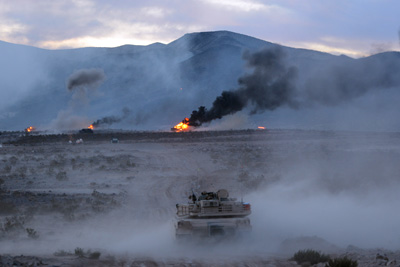
As part of the JFE exercise at the National Training Center, Fort Irwin, California, Aug. 5 and 6, about 1,500 service members provided a demonstration of American military power. Senior military leaders and journalists were invited to the training area in the dark of night to watch portions of the exercise -- the first of its kind in years.
The primary goal of the JFE was to use a joint capability to seize an airfield and then once secured, seize additional objectives and also expand the lodgment there to bring on a larger force, if needed. The concept of a joint force, working together, to come into an area held by an enemy, seize that area, and create an opening for follow-on American forces to enter into a battle space is a joint forcible entry.
"This is about deterrence. We are making sure everybody knows that we have a capability, if we have to, to force our way into an area, if it is in our nation's best interest," said Chief of Staff of the Army Gen. Ray Odierno. "I think it's important for everyone to understand we have this capability. That's why it is so important we work on this and practice it."
Soldiers with the 11th Armored Calvary Regiment at Fort Irwin, along with partners from XVIII Airborne Corps; 82nd Airborne Division; 75th Ranger Regiment; 3rd Battalion, 10th Special Forces Group (Airborne); as well as units from the U.S. Air Force were called upon, as part of the JFE, to demonstrate their ability to work together to project American military power anywhere across the globe.
Showing the interoperability of forces, highlighting the interdependence, and testing the ability of joint forces to work together, was a critical part of the JFE, said Gen. Joseph L. Votel, commander of U.S. Special Operations Command.
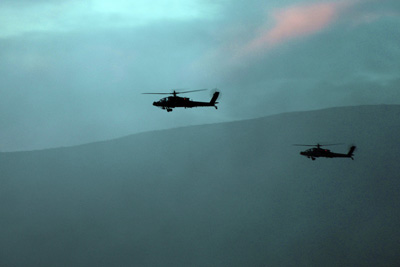
"One of the key lessons we've learned over the last 14-15 years of constant war from a Special Operations standpoint, is that we are hugely dependent on the conventional forces. We don't do anything by ourselves. We are completely enabled by them. So this interoperability, this integration, this interdependence ... is really demonstrative of how we want to work together in the future. It really provides our nation a much greater capability."
At dusk, in the middle of nearly 1,200 square miles of training space inside the Mojave Desert, tanker Soldiers with the 11th Armored Calvary Regiment -- a unit stationed at Fort Irwin that usually serves as the opposing forces for units who rotate in to the National Training Center to train -- lined up nine M1A1 Abrams battle tanks and fired on near-peer enemy forces from "Denovia," one of the two fictional countries involved in the conflict that was central to the exercise scenario.
Lt. Col. Jon Poole, the operations officer for the National Training Center, explained the training scenario in detail, which involved the fictional countries of "Atropia" and "Denovia."
Within the scenario, the four northern provinces of Atropia held elections nine months ago that put in charge a "Balosivar ethnic group," which he abbreviated as "BFB," that subsequently began ethnic cleansing of ethnic Atropians.
Three months later, "we saw some Denovian cross-border action that was condemned by the U.S. and Europe. The U.N. security council drafted some resolutions against the Denovian cross-border aggression," Poole said.
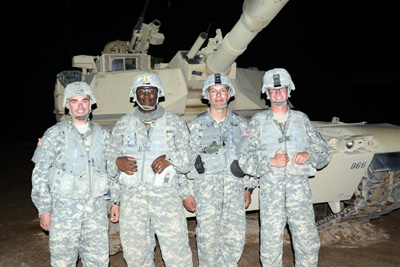
A month ago, he said "based on the BFB ramping up their cleansing, as well as Denovian actions along the border, some training actions, the U.S. sent some Special Operations Soldiers to assist in training some local personnel within those provinces in Atropia -- at the request of the Atropian government, in conducting unconventional warfare operations."
Finally, just nine days before the start of the JFE, he said, Denovian military forces, a near-peer army, crossed into Atropia.
WATCHING THE WAR UNFOLD
Spectators had been bussed into the "war zone" and set up on bleachers to watch the battle unfold. The tanks were just a short hike away from viewers. Those in the bleachers were instructed to wear ear and eye protection. Behind the scenes, an announcer called a play-by-play of the action over a loud speaker.
Using their tank's main guns, along with machine gun fire, and aided by AH-64 Apache aircraft, the tankers delivered devastating blows to enemy Denovian forces.
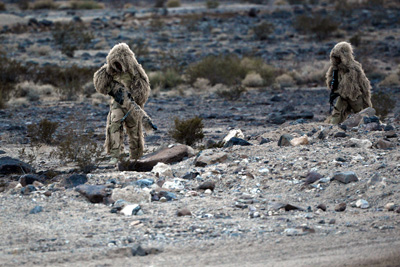
"They are holes now," said Capt. William Larsen of their targets. He served as commander of one of the tanks, as well as commander of Delta Company, 1st Squadron, 11th [Armored Cavalry Regiment], known as the "Death Dealers."
"What we did was set the conditions for the bigger picture for the JFE exercise. It kind of tells the story about an artillery raid being done by the High Mobility Artillery Rocket System (HIMARS)," he said. "We attacked forward to create the space for that HIMARS to move in and destroy air defense in the vicinity of objective Desoto."
"Everything went off as planned without a hitch," Larsen said. "All the guys were shooting great. All the crews were doing the right things. There was great movement. Everything looked and sounded great."
Once Larsen and the other tanks had made the area safe, a HIMARS rolled in and fired off several rockets meant to take out enemy air defenses that were protecting a landing strip located at "Objective Desoto" -- another part of Fort Irwin where spectators would later be taken to watch another part of the exercise.
"This is kind of the next step," Larsen said of the JFE. "It's something that hasn't been practiced as much in the last ten years, where we had focused on counter-insurgency. This is really to show, and practice, being able to integrate different international and intergovernmental agencies, and within the services as well; to be able to project combat power forward if needed."
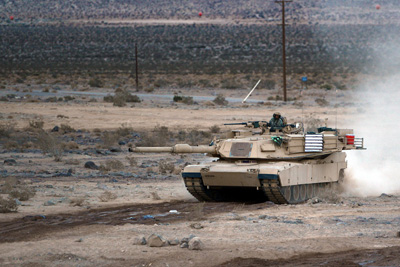
Sgt. Zachary Egan, in the Army for four years now, served as the gunner in Larsen's tank. He said he fired off three rounds from the tank's main gun. "It's awesome, especially when you see the round impact downrange," Egan said of pulling the trigger.
Egan said he recognizes the importance of the JFE and of the spectators on the battlefield, as a way to demonstrate to decision-makers just how important it is what he and his team does.
"For us as tankers, this is our job. We realize where we fit in on the battlefield. Others, they are looking at budgets. And this is kind of an expensive beast," he said, pointing to his tank. "To us, it's still a necessary beast. To me, this kind of shows other people that don't get exposed to this, how important we are on the modern battlefield."
Larsen, Egan, tank driver Spc. Levi Benson and shell loader Sgt. Jonathan Oliver -- the four crew members from just one of the Abrams tanks that had participated -- made themselves available to spectators after the initial demonstration. They had driven their tank the short distance to the spectator stand. They stood near their tank and answered questions from civilian reporters and generals alike. Off in the distance, miles away from spectators, the targets of their live-fire exercise still burned.
THREE OBJECTIVES
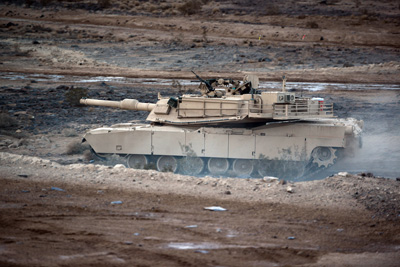
The HIMARS had launched rockets over a distant mountain, not at the enemy vehicles that were visible at the base of those mountains. Where those rockets hit was not visible to spectators. But they were in fact aimed at enemy air defenses on the other side of the mountains that were protecting the landing strip American forces aimed to seize as part of "Objective Desoto."
After watching Abrams tanks and three Apache helicopters eliminate Denovian forces, and the HIMARS launch its rockets over the mountains, spectators were bussed to a nearby landing strip and loaded aboard CH-47 Chinook helicopters for a 12-minute ride to Objective Desoto, where they would watch the second phase of the operation.
Desoto actually included three sub-objectives -- each with their own name. First was the landing strip, called "Objective Coolidge." Rangers with the 2nd Battalion, 75th Ranger Regiment, flying in CV-22 Osprey aircraft from Joint Base Lewis-McChord, Washington, about 900 miles north would be responsible for securing the strip.
To the west of the landing strip, about 1,500 meters away, is a small town called "Nur" on the Fort Irwin map. For visitors, it's one of a dozen or more fabricated prop-towns that are used for training purposes. The Army built these small towns, like Hollywood sets, all over Fort Irwin. For the Army Rangers participating in the JFE exercise, it was "Objective Carter."
Less than 300 meters south of the landing strip was "Objective Cleveland," another training town on Fort Irwin, called "Dezashah." Paratroopers from 2nd Brigade, 82nd Airborne, would drop from the sky onto the landing strip -- after it had been secured by the Rangers -- and then proceed south to take control of the town.
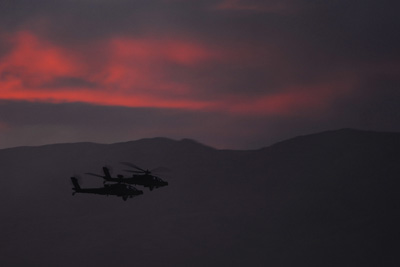
Up in the mountains overlooking Objective Desoto were Soldiers of 3rd Battalion, 10th Special Forces Group, known as Green Berets.
"They have been there for days, watching this objective. Real Soldiers, watching and reporting everything that's been going on out here," said Lt. Gen. Stephen J. Townsend, commander of the XVIII Airborne Corps.
Townsend explained to spectators how the Green Berets had used "covert infiltration platforms to sneak their guys into the battlefield."
Outside a large hospitality tent set up near the landing strip were two trucks. One was a flatbed loaded with hay bales. The center was hollowed out so Green Berets could hide in the center. Another, a panel truck with the rear door open, looked as if it was loaded with household goods to be taken off to the city junkyard. At the very back, pointing outward was a washer and dryer unit. The door to the dryer was open and it was possible to crawl into the dryer, right through its back, into the empty space at the rear of the truck where more Green Berets could hide.
Seizing Objective Desoto took the coordinated efforts of conventional forces and special operations forces. First, there were pre-assault fires around the airstrip. F-15 Eagle fighter jets, provided by the Air Force, over-flew the landing strip and dropped munitions on various enemy air-defense targets that had been highlighted by Green Berets.
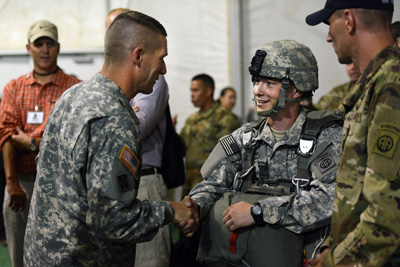
Clearing out those enemy forces enabled the Rangers to seize the landing strip. They had flown in from Joint Base Lewis-McChord in CV-22 Ospreys. The tilt-rotor aircraft were able to land vertically, like helicopters, and drop off the Rangers, and then quickly return to the sky.
With the Rangers on the ground, the landing strip was secured. This allowed follow-on forces, the 82nd Airborne, to fly in from nearby March Air Force Base in C-130 aircraft and drop both equipment and Soldiers onto the landing strip via parachute.
Spectators, who had each been given night-vision scopes with which to watch the operation at the landing strip, wouldn't be able to see the Rangers and the 82nd take the two nearby towns that were held not by Denovian conventional forces, but terrorist forces. Nor would spectators be able to see additional U.S. forces or equipment come in, or the noncombatant evacuation operation that would happen later in the day.
What they had seen was the Rangers and the 82nd safely on the ground, with the landing strip secured -- thanks to a joint effort that involved both special and conventional forces, as well as the U.S. Air Force.
The JFE involved special forces and conventional forces working together against a "hybrid threat" that included insurgents, terrorists, criminal elements and conventional near-peer forces.
Votel said the lessons learned from the JFE will ensure the Army is ready for any fight it may face in what the Army's chief of staff has called an increasingly complex world.
"This creates more muscle memory with these organizations. While we may never exactly replicate exactly what we are doing tonight, there will be lessons learned; there will be experiences out of this, we will see things that go well, things that don't go as well as we want them to, and we will learn from that," Votel said. "This is about building readiness and about creating experiences together that allow us to provide options and do things in a more effective way in the future."
Odierno said the real-world missions similar to the scenario that drove the JFE could happen anywhere in the world.
"It's up to us to have the capability to go anywhere anytime, no matter what continent it is, and be able to put a joint capability on the ground that can secure terrain that then allows us to bring on follow-on forces," Odierno said. "We have the capability to do this."
The general said the JFE exercise is something he wants to see happen on a yearly basis.